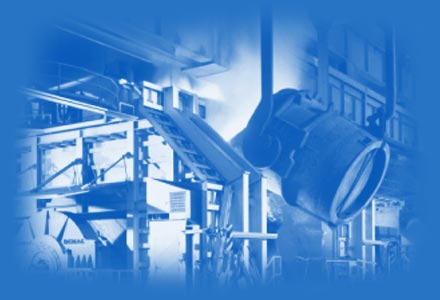Sales of pig iron
Pig iron
Pig iron is the immediate product of smelting iron ore with coke, limestone and other ingredients in a blast furnace. A high carbon content - more than 2.14%, typically more than 3.5%. Due to their high carbon content is hard and brittle when heated to temperatures of 1150 ° C to 1250 ° C. It melts without passing through moldable state.Therefore it can not be shaped by heat or cold. Also called non- ductile iron and its direct use is very limited. However, it is the starting material for the manufacture of other types of technical iron.
Form of carbon
The pig iron carbon can exist in two forms:
- At slow cooling, and the greater silicon content (2-4%) is excreted in the form of carbon graphite crystals among the crystals of iron. Such iron has a gray fracture, is therefore called a gray pig iron. The carbon content is usually 3.5 to 4.2%.
- During rapid cooling there is not enough time for crystallization, while the larger manganese content (up to 6%) is a compound of carbon with iron - iron carbide (Fe3C), also called cementite. Such iron has a white fracture so called white pig iron. The carbon content is usually up to 4.5%.
Distribution of iron and its products
Pig iron and subsequent products are divided into:
- gray pig iron - the more carbon is excreted in the form of graphite, the darker the color, the softer and better worked. It is good for casting, most are therefore used for foundry purposes.
- steel
- foundry
- cast iron
- hard iron
- vaccinated iron
- ductile iron
- alloyed cast iron
- alloy cast iron
- cast iron
- white pig iron - the more carbon is excreted in the form of graphite, the darker the color, the softer and better worked. It is good for casting, most are therefore used for foundry purposes.
- steel
- foundry
- white iron
- malleable cast iron alloy
- white iron
- special pig iron - ferro-alloy - in addition to carbon usually contains other elements manganese, silicon, chromium, vanadium, molybdenum, vanadium. Used as an additive in the manufacture of aluminum alloy - alloy steel and cast iron.
Production
Pig iron produced in blast furnace reduction of iron ore with carbon monoxide orcarbon at high temperatures. In the process of are entering the following raw materialscontaining iron:
- iron ore - mostly magnetite, hematite, limonite and siderite,
- steel waste - most scalings that arise in forming the hot steel and contain up to 55%iron,
- roasted iron pyrites - waste in the manufacture of sulfuric acid and containing 60%iron,
- blast furnace dust - obtained by purification of blast furnace gas.
Apart from them enters the process:
- coke - which performs three tasks:
- serve as fuel to achieve the necessarytemperature, is blown into the oven preheated.
- the carbon from it enters the reactionas a reducing agent.
- carbon it produced carburize pure iron. - air - necessary to sustain combustion.
- slagging ingredients - allowing better separation of gangue and ash, and the creation of debris, such as limestone.
Blast furnace products are:
- pig iron - the main product,
- blast furnace gas - is used as fuel,
- blast furnace slag - - that is further processed to blast cement, slag wool, cobbles,gravel, slag, slag sand and other products.




